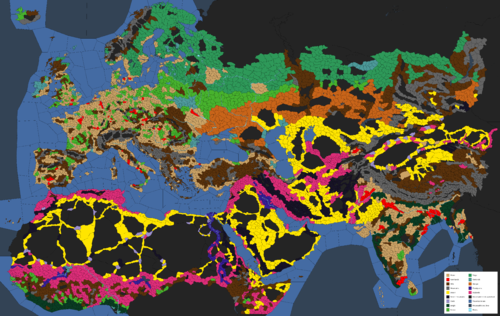| 地产 | 等级及革新要求 | 地产效果 | 特殊效果 |
|---|---|---|---|
城堡 可持有: 封建制 氏族制 共和制 神权制 骑士团 |
城寨 |
圩田文化传统 及 沿海:建筑的建造时间:
城堡守护者文化传统: | |
| 城堡主楼 |
圩田文化传统 及 沿海:建筑的建造时间:
城堡守护者文化传统: | ||
| 轴心环形城堡 |
圩田文化传统 及 沿海:建筑的建造时间:
城堡守护者文化传统: | ||
| 要塞 |
圩田文化传统 及 沿海:建筑的建造时间:
城堡守护者文化传统: |
男爵领(Barony)是最低等级的实地头衔,也是唯一不可玩的头衔等级(即使它们可以被可玩角色持有)。每个伯爵领拥有 1 到 7 个男爵领,男爵领的拥有权总是和伯爵领相联(男爵领和伯爵领总是在同一领地)。男爵领可能人烟稀少,也可能有一个地产。
首都(府)
一个男爵领可以是两类首都(府):
 伯爵领首府是一个伯爵领的初始男爵领。其地产永远不能摧毁或租赁,且总是归持有该伯爵领头衔的统治者持有。与其他级别较低的地产相比,伯爵领首府允许建设一个额外的建筑,同时有 +1
伯爵领首府是一个伯爵领的初始男爵领。其地产永远不能摧毁或租赁,且总是归持有该伯爵领头衔的统治者持有。与其他级别较低的地产相比,伯爵领首府允许建设一个额外的建筑,同时有 +1  城防等级。此外,如果该伯爵领是其法理公国的首都,则伯爵领首府拥有一个额外的公国建筑槽。当统治者拥有伯爵领的另一块地产时,可以更改伯爵领首府到该地产所在的男爵领。
城防等级。此外,如果该伯爵领是其法理公国的首都,则伯爵领首府拥有一个额外的公国建筑槽。当统治者拥有伯爵领的另一块地产时,可以更改伯爵领首府到该地产所在的男爵领。 领地首都是统治者及其宫廷驻在之地产(男爵领),并且总是由第一继承人继承。领地首都一生只能移动一次,除非是迁往主头衔的法理首都。领地首都也提供额外的 +1
领地首都是统治者及其宫廷驻在之地产(男爵领),并且总是由第一继承人继承。领地首都一生只能移动一次,除非是迁往主头衔的法理首都。领地首都也提供额外的 +1  赋税。领地首都所在法理公国下的男爵领获得 +10%
赋税。领地首都所在法理公国下的男爵领获得 +10%  征召兵。战争期间不能迁都。
征召兵。战争期间不能迁都。
地产
每个男爵领可以有一个地产,代表位于其中的中心聚落。可用男爵领要求拥有地产。建造新地产将为此男爵领创建一个头衔,可以持有或授予其他角色。不是伯爵领首府的男爵领可以被授予一位低级贵族。如果在封臣的伯爵领建设地产,伯爵领拥有者会在地产建设完成后自动获得地产。所有地产建造后是Ⅰ级,可以升级至Ⅳ级。建造或升级一处地产花费 ![]() 5 年时间,除非有增益或惩罚。无论拥有何种特质,放弃无法控制(无法获得任何赋税或征召兵)的地产不会获得压力。每个地产都可以建造一些建筑。
5 年时间,除非有增益或惩罚。无论拥有何种特质,放弃无法控制(无法获得任何赋税或征召兵)的地产不会获得压力。每个地产都可以建造一些建筑。
注意:以下花费均为没有增益或惩罚的花费。
- 建造封建制/氏族制地产(城堡/城市/神殿)需要
 400金钱。如果伯爵领未同时拥有城堡、城市和神殿地产,必须首先建造缺少的地产类型。
400金钱。如果伯爵领未同时拥有城堡、城市和神殿地产,必须首先建造缺少的地产类型。 - 升级一处封建制/氏族制地产到Ⅱ级需要
 550金钱
550金钱 - 升级一处封建制/氏族制地产到Ⅲ级需要
 700金钱
700金钱 - 升级一处封建制/氏族制地产到Ⅳ级需要
 850金钱
850金钱 - 升级一处部落制地产需要
 485威望和
485威望和  200金钱
200金钱 - 部落制地产不能被建造,但封建制和氏族制统治者可以花费 500
 金钱将其转换为城堡。
金钱将其转换为城堡。
建造完成一处神殿地产将给予其所在伯爵领头衔的持有者 500 ![]() 虔诚,并且伯爵领头衔持有者的信仰的
虔诚,并且伯爵领头衔持有者的信仰的 ![]() 宗教热情增加1%,无论是哪位统治者提供了建造资金。
宗教热情增加1%,无论是哪位统治者提供了建造资金。
| 地产 | 等级及革新要求 | 地产效果 | 特殊效果 |
|---|---|---|---|
城市 可持有: 共和制 骑士团 |
中心村镇 |
共和制传承 或 乡土观念文化传统:
城市守护者文化传统:民众好感度: +5 | |
| 大型城市 |
共和制传承 或 乡土观念文化传统:
城市守护者文化传统:民众好感度: +10 | ||
| 城区 |
共和制传承 或 乡土观念文化传统:
城市守护者文化传统:民众好感度: +15 | ||
| 繁华都会 |
共和制传承 或 乡土观念文化传统:
城市守护者文化传统:民众好感度: +20 |
| 地产 | 等级及革新要求 | 地产效果 | 特殊效果 |
|---|---|---|---|
神殿 可持有: 神权制 平信徒神职人员 |
圣堂 |
圩田文化传统 及 沿海:建筑的建造时间: | |
| 神殿之地 |
圩田文化传统 及 沿海:建筑的建造时间: | ||
| 崇拜之所 |
圩田文化传统 及 沿海:建筑的建造时间: | ||
| 大殿 |
圩田文化传统 及 沿海:建筑的建造时间: |
| 地产 | 等级及革新要求 | 地产效果 | 特殊效果 |
|---|---|---|---|
部落 可持有: 部落制 |
部落建筑 无 |
|
|
| 加固部落建筑 |
|
|
地形
每个男爵领都有一种特定的主导地形。地形决定了军队在男爵领的移动速度和战线宽度,也影响伯爵领的补给上限和发展度增长。地形还决定伯爵领可以建造的建筑。游戏中有14种地形:
冬季
除了沙漠区域附近外的所有男爵领每年都会经历冬季。冬季在十月中旬开始,严寒度随时间增加,但不一定每年都一样。男爵领受冬季影响的开始时间和严寒度基于在地图上的位置,极北之地和高山地区受影响最早且最严重。冬季在三月初结束。某些兵士会在冬季获得增益或惩罚。
| 严寒度 | ||||
|---|---|---|---|---|
 温暖 温暖
|
-2 | 0 | 0 | |
 正常 正常
|
-5 | 0 | 0 | |
 严寒 严寒
|
-10 | +20% | +5 |
瘟疫
A plague is an outbreak of a contagious disease trait that spreads across the map. If a plague is present within a ruler's domain they unlock the Isolate Capital and Enter Seclusion decisions. If a plague is present within the player's realm or the realm of a neighbor then a button will appear in the lower-right corner, showing all plagues.
Affected baronies have an Infection Rate that determines the penalties they get their severity. The maximum Infection Rate is reduced by a percentage equal to the county's ![]() Plague Resistance, which also reduced their spread.
Plague Resistance, which also reduced their spread.
- If
 Plague Resistance is above 10 plagues are 25% less likely to spread to or increase Infection Rate in the barony.
Plague Resistance is above 10 plagues are 25% less likely to spread to or increase Infection Rate in the barony. - If
 Plague Resistance is above 50 plagues are 50% less likely to spread to or increase Infection Rate in the barony.
Plague Resistance is above 50 plagues are 50% less likely to spread to or increase Infection Rate in the barony. - If
 Plague Resistance is above 80 plagues are 75% less likely to spread to or increase Infection Rate in the barony.
Plague Resistance is above 80 plagues are 75% less likely to spread to or increase Infection Rate in the barony.
The number of buildings increase the chance for a plague to appear or spread in a barony, especially ![]() tradeports,
tradeports, ![]() markets,
markets, ![]() guilds, or if the holding is a
guilds, or if the holding is a ![]() city. Plagues spread faster across coastal regions. They are less likely to spread to islands, with the exception of Great Britain. Once a plague ends the affected baronies will receive a
city. Plagues spread faster across coastal regions. They are less likely to spread to islands, with the exception of Great Britain. Once a plague ends the affected baronies will receive a ![]() Development growth bonus for 5 years and will be 4 times more resistant to the same plague for 50 years and to other plagues for 15 years.
Development growth bonus for 5 years and will be 4 times more resistant to the same plague for 50 years and to other plagues for 15 years.
Each plague will have one of three levels of intensity, which affects their duration, number of baronies that will be affected, and chance for characters to get infected. The ruler who has the source of the outbreak within its domain will lose 20, 50 or 100 ![]() Legitimacy depending on intensity.
Legitimacy depending on intensity. ![]() Development and later eras increase the chance for a plague to be of higher intensity.
Development and later eras increase the chance for a plague to be of higher intensity.
| Plague | Barony effects (over 10% infection rate) | Barony effects (over 50% infection rate) | Barony effects (over 80% infection rate) | Affected baronies | Duration | Notes | DLC |
|---|---|---|---|---|---|---|---|
Bubonic Plague
|
|
|
|
|
|
Spreads faster than other plagues | |
Consumption
|
|
|
|
|
|
||
Smallpox
|
|
|
|
|
|
||
Typhus
|
|
|
|
|
|
||
Bloody Flux
|
|
|
|
|
|
Spreads faster in baronies that have armies or fortifications | (lod为Template:Icon中的未知key) |
Holy Fire
|
|
|
|
|
|
(lod为Template:Icon中的未知key) | |
Measles
|
|
|
|
|
|
Children are more likely to get infected | (lod为Template:Icon中的未知key) |
An Apocalyptic ![]() Bubonic Plague will always be named Black Death. Every ruler will be notified when it appears and when it spreads inside their borders. Where it can appear, how it spreads and whether it can appear multiple times depends on Game Rules. If the
Bubonic Plague will always be named Black Death. Every ruler will be notified when it appears and when it spreads inside their borders. Where it can appear, how it spreads and whether it can appear multiple times depends on Game Rules. If the ![]() Legends of the Dead DLC is installed there will be numerous unique events that can happen during Black Death.
Legends of the Dead DLC is installed there will be numerous unique events that can happen during Black Death.
When a barony is infected its county will lose ![]() Development. The penalty scales inversely with the number of baronies so for example a county with 3 baronies will lose 3 times less
Development. The penalty scales inversely with the number of baronies so for example a county with 3 baronies will lose 3 times less ![]() Development per infected barony than a county with 1 barony.
Development per infected barony than a county with 1 barony.
参考资料




























